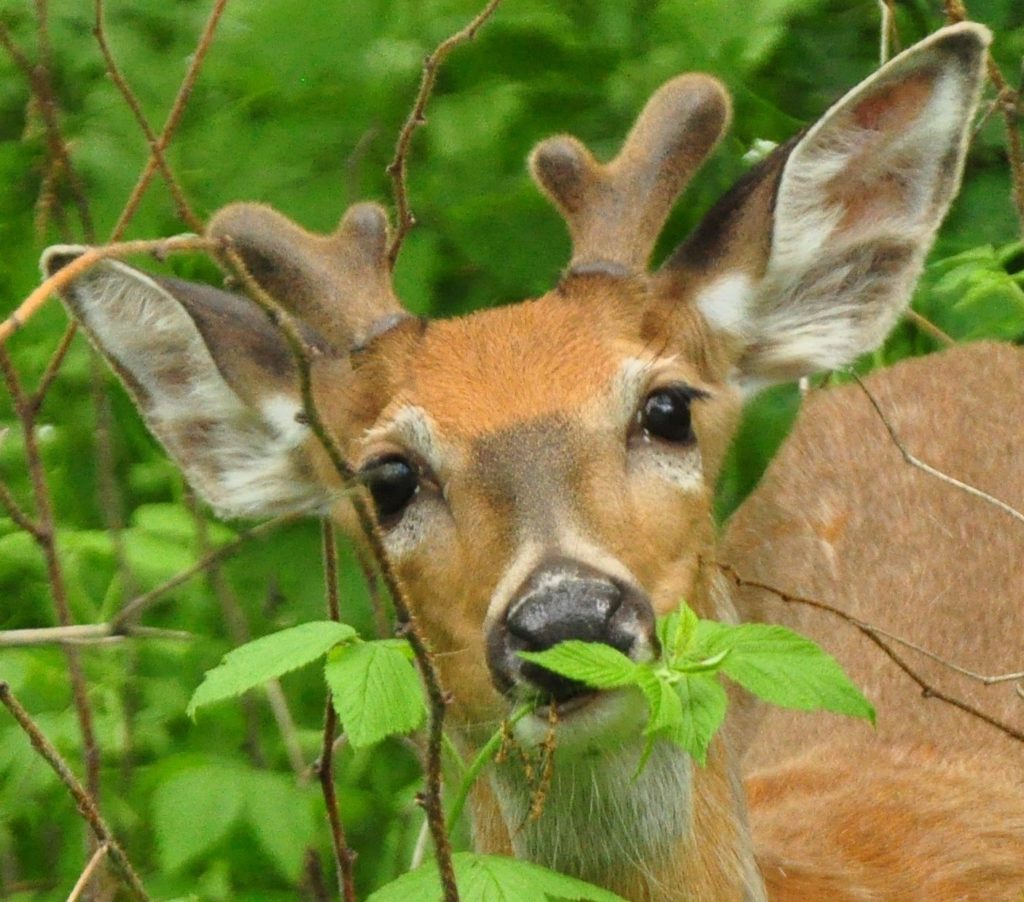Photography courtesy of Lowell Washburn, all rights reserved.
The white-tailed deer is one of Iowa’s most economically and recreationally important species of wildlife. For deer hunting enthusiasts, it’s never too early to start thinking of fall. I was reminded of that fact earlier this week when a yearling buck suddenly stepped out of the woodland shadows and into full view. Pausing at a distance of around twenty yards, the deer provided a good view. The first thing I noticed were the blunt, velvet covered appendages jutting from the top of its head. Although the club-shaped growths are soft and delicate now, the budding antlers will have matured into glistening weaponry by early October. The thoughts of what they’ll become made me yearn for the cool crisp days of autumn.

I am not alone in those thoughts. Human hunters have long been fascinated with deer and their antlers. Early sporting artwork — drawn on smoky cave walls — depicts ancient hunters in hot pursuit. For some hunters, this age-old fascination has given way to modern-day obsession. In extreme cases, the obsession is carried to such unreasonable levels that the quest for antlers becomes an impairment to all other meaningful endeavors.
Deer antlers are often incorrectly referred to as horns. Animals that grow horns – American bison and bighorn sheep – wear them for life. Antlers are temporary. For white-tailed deer, shedding and growing antlers is an annual event. The results are beyond spectacular. Nowhere do deer have the potential to grow bigger or better than right here at home. To date, Iowa has produced 19 of the all-time top deer ever recorded. That’s more top scoring deer than is listed by any other state or Canadian province.
For white-tailed bucks, antlers are more than a fashion statement. They are, in reality, deadly weapons. The sole purpose of these magnificent, pitchfork appendages is to do battle with and exert dominance over other bucks — particularly during the fall breeding season. But their usefulness is brief. As soon as the annual rut concludes, deer have no further use for heavy weaponry. By mid-winter, bucks are shedding used antlers like a bad habit.
Although it must feel good when a deer is relieved of its cumbersome armament, the enjoyment is short lived. Within the month, a brand-new set of antlers will begin to sprout. Antler growth is an amazing process. Anchored to a round base called a pedicle, budding antlers are living tissue – soft, delicate and easily damaged. Nourished by a soft and hairy covering called velvet, antlers exhibit their most impressive growth spurts during June and July. Size and shape of the completed product depends on many factors including type and abundance of forage, soil quality and mineral availability, stress, genetics and a host of less understood environmental factors.
As summer wanes, antler growth suddenly slows as blood supplies to the velvet diminish rapidly before ceasing entirely. Hormonal changes and decreasing amounts of daylight have provided a clear signal that it is time for antlers to calcify. By late August, mineralization is complete; the nourishing layer of velvet has served its purpose. Deprived of nutrients, the soft covering dies, shrinks and soon hangs in ragged shreds.
By early September, the buck’s antlers are sparkling with newly polished elegance; ready to aid its owner in the age-old struggle for dominance. The fall passes quickly. Following weeks of intense dueling, the annual rut concludes, and winter snows soon encase the landscape. Antlers that were a primary asset just one month ago have now become a liability. There is a survival solution. Get rid of everything you don’t need. In a poorly understood process, a buck simply “demineralizes” a thin band of antler at the top of each pedicle. Within days – sometimes hours — the antlers fall to the ground. Within the month, a new set of antlers will begin their amazing, seven-month journey.

 Tom Cope
Tom Cope Sue Wilkinson
Sue Wilkinson Susan Judkins Josten
Susan Judkins Josten Rudi Roeslein
Rudi Roeslein Elyssa McFarland
Elyssa McFarland Mark Langgin
Mark Langgin Adam Janke
Adam Janke Joe Henry
Joe Henry Kristin Ashenbrenner
Kristin Ashenbrenner Joe Wilkinson
Joe Wilkinson Dr. Tammy Mildenstein
Dr. Tammy Mildenstein Sean McMahon
Sean McMahon